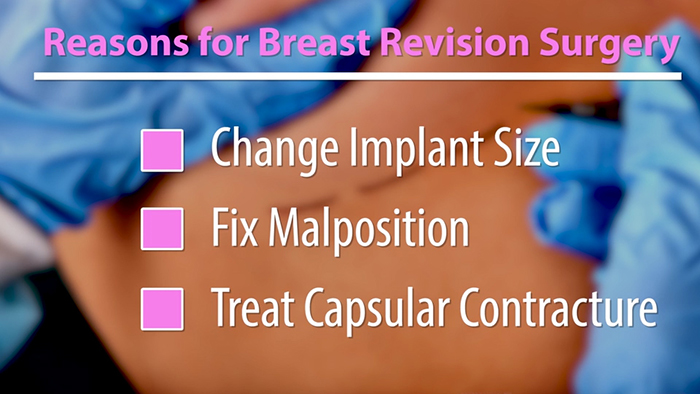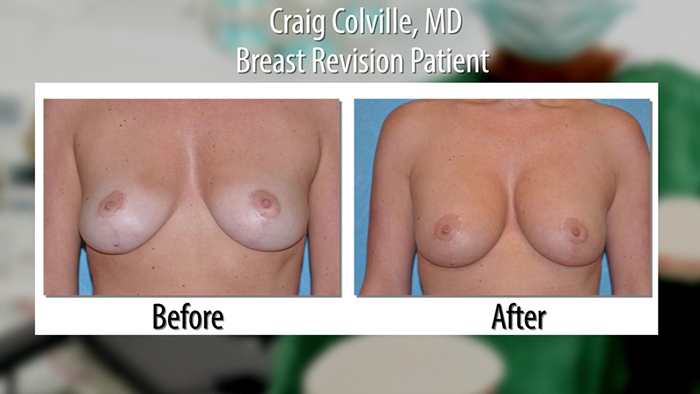Breast augmentation revision surgery is a specialty in and of itself. It takes immense experience and know-how for a surgeon to correct that which maybe have been once corrected before. The second procedure can be uncharted waters, and thus requires a demanding surgical skill set.
Dr. Craig Colville of Toledo, Ohio speaks on the challenges of breast revision surgery, often finding himself transforming a “less than optimal” result into the positive change the patient expected the first time. “There are a wide variety of issues that cause a patient to seek a revision,” he explains. “Sometimes a patient simply changes their mind about size. The more difficult revisions are those where a woman has actually had two to three surgeries, and none of them truly addressed the original problem they were trying to correct.”
Reasons for Revision
Revisional breast surgery may be necessary or desired after either cosmetic or reconstructive breast procedures. Since neither saline nor silicone implants last a lifetime, sometimes it is as simple as exchanging an old or maybe ruptured implant. Conversely, the issue may be predicated on one or more problems.
Colville most commonly sees patients who want to revise the size of their implant, or add a lift to counteract the effects of gravity and/or pregnancy if they have implants. “Changing the size or type of implant or performing a breast lift with new implants is technically a revision surgery, but it is inspired by a change the patient is seeking to improve – not the effect of a disappointing primary surgery,” he explains. Common reasons for breast revision surgery to correct poor outcomes include, but are not limited to
- Capsular Contracture
- Implant Malposition
- Asymmetry
Hardening of the Breasts
Capsular contracture (hardening of the breasts) is rare, but occurs often enough for surgeons to be well-versed with it’s prevention and how to correct it. The condition is characterized by a tightening around the implant, a reaction of the body to the implant. “The implant itself doesn’t get hard, but the pocket around the implant lining can pull up, change shape and cause pain,” describes Colville.
While it cannot be completely prevented, there are steps surgeons take to minimize the risk of contracture. “I use a ‘no touch’ technique, triple antibiotic irrigation and a pure meticulous bloodless dissection,” shares Colville. Another preventative measure Colville prefers is an incision below the breast so as to seal the nipple away from any contact with the implant.
Poor Position or Uneven Breasts
Many revision procedures are from poorly placed implants that affect the aesthetics. “Malposition is where the implant is not where you want it,” says Colville. “This is the effect of the placement or pocket being dissected incorrectly.” This can happen if a women’s natural breasts are significantly asymmetrical to begin with. “If there is a noticeable difference in the breasts to start with, and a surgeon tries to overcompensate by putting the implant below the fold of the natural breast, you may have a result where there is a double bubble under the breast.”
The Power of Communication
Revisional breast surgery has unique considerations that differ from an initial breast procedure. Comprehensive communication and extensive experience are critical elements to success. The concerns and goals must be clear and prioritized. Size? Position? Rippling? Palpability? It’s critical that the goals of breast revision are both defined and realistic.
“Quite often there was no discussion in consultation about why the woman wasn’t happy with her breasts, and what her expectations were. Then, it’s no wonder when the surgery either doesn’t meet their goals, or the result doesn’t fit their body. At that point, the surgeon has created a new problem instead of a solution.” – Dr. Colville
New Technologies
New technologies like Acellular Dermal Matrix material, fat transfer, and newer surgical techniques have revolutionized revisional breast surgery and allowed for consistently successful outcomes. Materials like Strattice® and GalaFLEX® act like an internal bra, supporting and shaping the new breast if there is a need. This is essential to revising issues such as symmastia (loss of natural cleavage), bottoming out of the implant, lateral displacement, and visible rippling. “Using these advanced materials reinforces women’s tissues. They are tools commonly used for implant revision surgeries. They help protect against relapse and failure,” says Colville.
A Surgeon’s Point of View
Anticipation on the part of the surgeon is key as secondary breast revision may be unpredictable. The challenge of breast implant revision surgery is taking the patient to the operating room without having the ability to be fully aware of the scope and specter of the problem. Issues caused by the first surgery might only be discovered during the second surgery.
Dr. Colville says this requires focus, creativity and persistence until an aesthetic and stable result can be achieved. “The best time to get an optimal long term result is the first time. Revisions are inherently more difficult for both the patient and surgeon. That is why I stress that patients seek opinions from only board certified plastic surgeons who specialize in the procedure they are having. Get it right the first time. It’s your best chance.”


















Facebook
Twitter
Instagram
YouTube
RSS